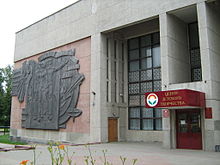- Pioneers Palace
-
 Young Pioneer Palace in Sevastopol
Young Pioneer Palace in Sevastopol
Young Pioneer Palaces or Palaces of Young Pioneers and Schoolchildren were youth centers designated for the creative work, sport training and extracurricular activities of Young Pioneers and other schoolchildren. Young Pioneer Palaces originated in the Soviet Union (USSR) and still exist in some socialist states.
The predecessors of Young Pioneer Palaces were established during 1920th-30th in Moscow and were later organized in Leningrad, Sverdlovsk, Tbilisi, Kiev, Irkutsk and other cities and towns of the Soviet Union. The first Young Pioneer Palace was established in Kharkov in the former House of Noble assembly on the 6th September 1935 Website of the Kharkov Regional Palace of Children and Youth Creativity. In 1971 there were more than 3,500 Young Pioneer Palaces in the country. The early ones were organized at re-equipped palaces and personal residences of royals of the Russian Empire, and were nationalized shortly after Soviet power was established in 1922. The former Anichkov Palace, for example, became the Zhdanov Palace of Young Pioneers in Leningrad, named after Andrei Zhdanov. Zhdanov Palace was one of the most well-known Young Pioneer Palaces of the Soviet Union. Newly built ones were constructed in the architectural style of ancient palaces until the late 1950s, when new architectural styles began to be introduced. Two of the largest Young Pioneer Palaces were built in the new style: Moscow Palace of Young Pioneers, built in 1959-1963, and Kiev Young Pioneer Palace, built in 1965.
 The former Pioneers' Palace in Sormovo, now renamed "Children's Creative Activity Center"
The former Pioneers' Palace in Sormovo, now renamed "Children's Creative Activity Center"
There were some essential differences between Soviet secondary schools and Young Pioneer Palaces. The latter consisted of specialized hobby groups and sections. Entrance for schoolchildren was not mandatory, and educational programs in Young Pioneer Palace hobby groups were designed so that they didn't duplicate school programs. However, there were also some similarities: hobby groups were organized by children's ages, similar to school classes; and admittance to Young Pioneer Palaces was completely free of charge. Educational work at the Palaces was designed to cultivate children's interests in labour, knowledge, development of creative abilities, professional orientation, and amateur talent activities. There were various sports, cultural and educational, technical, political, artistic, tourist, and young naturalist hobby groups in Young Pioneer Palaces. One of the main stated principles of educational work in hobby groups was: "Having been taught, now teach your comrade".
After the breakup of the Soviet Union, most of the Young Pioneer Palaces were closed. Some reopened as youth centers, but admittance ceased to be free of charge.
Many Young Pioneer Palaces were built in Eastern Bloc countries and other Soviet allies during the existence of the Soviet Union. Some of them still exist, such as Hanoi Young Pioneer Palace in Vietnam, Ernesto Che Guevara Central Pioneer Palace in Havana, Cuba, and Palace of Pioneers and Schoolchildren in Pyongyang, North Korea. Chinese Young Pioneer Palaces have mostly either have been converted for other uses or are privatized and run for profit.
References
- (in Russian) Great Soviet Encyclopedia. (3rd ed. ed.). Moscow: Sovetskaya Enciklopediya. 1972. vol. 7, pp. 595–596.
See also
External links
Categories:- Young Pioneers of the Soviet Union
- Soviet Union
Wikimedia Foundation. 2010.

